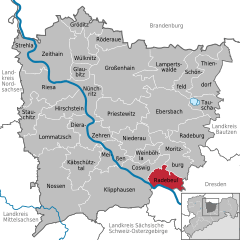Radebeul
| Radebeul | ||
|---|---|---|
 | ||
| ||
 Radebeul | ||
Location of Radebeul within Meißen district 
 | ||
| Coordinates: 51°06′N 13°39′E / 51.100°N 13.650°ECoordinates: 51°06′N 13°39′E / 51.100°N 13.650°E | ||
| Country | Germany | |
| State | Saxony | |
| District | Meißen | |
| Government | ||
| • Mayor | Bert Wendsche | |
| Area | ||
| • Total | 26.06 km2 (10.06 sq mi) | |
| Elevation | 101 - 256 m (−739 ft) | |
| Population (2012-12-31)[1] | ||
| • Total | 33,279 | |
| • Density | 1,300/km2 (3,300/sq mi) | |
| Time zone | CET/CEST (UTC+1/+2) | |
| Postal codes | 01435-01445 | |
| Dialling codes | 0351 | |
| Vehicle registration | MEI | |
| Website | www.radebeul.de | |
Radebeul is a town (große Kreisstadt) in the Elbe valley in the district of Meißen in Saxony, Germany, a suburb of Dresden. It is well known for its viticulture, a museum dedicated to writer Karl May and a narrow gauge railway connecting Radebeul with the castle of Moritzburg and the town of Radeburg. The Meißen area, where Radebeul is located, is one of the northeasternmost areas where wine is grown today.
It is sometimes called "Saxon Nice" for its pleasant landscape and mild climate.
History
A village Radebeul was first mentioned in 1349. In 1905 it absorbed the neighboring village of Serkowitz. On April 1, 1924 Radebeul became a town. Meanwhile, the neighboring village of Kötzschenbroda had taken over Lindenau in 1920 and Naundorf, Zitzschewig und Niederlößnitz by 1924, when it was made a town as well. In 1934 Wahnsdorf and Oberlößnitz joined Radebeul, and on January 1, 1935 the towns of Kötzschenbroda and Radebeul were united under the name of Radebeul ("Kötzschenbroda" having a Slavic root, this name was considered too "ungermanic" at the time). In 1947 Radebeul was made part of the district of Dresden. In 1995 it received the status of a major town inside the rural district (große Kreisstadt); when the rural district of Dresden (Dresden-Land) was dissolved, Radebeul became part of the district of Meißen.
Transportation
The town can be reached by Dresdner Verkehrsbetriebe tram route 4 or by Dresden S-Bahn line S1, which serves four stations in Radebeul. Deutsche Bahn regional trains 18 and 50 also stop at Radebeul Ost station. Radebeul Ost is also the terminus of the historic Radebeul–Radeburg narrow-gauge steam railway and the station closest to the Karl May Museum.
Main sights

Radebeul has been renowned for its vineyards since 1324. It lies on the Saxon Wine Road.
Theatre
- Landesbühnen Sachsen
Museums
- Karl May Museum
- Stadtgalerie Radebeul
- Hoflössnitz Stiftung Weingutmuseum
- Volkssternwarte „Adolph Diesterweg“
- "Zeitreise" Interessantes zur DDR-Zeit
Edifices
- Karl-May-Museum (Villa Shatterhand and Villa Bärenfett)
- Grave of Karl May
- the Bilzbad (named after Friedrich Eduard Bilz 1842-1922)
- the Sorgenfrei House, a Weingut, built 1785/1788 in the so-called Dresdner Zopfstil (between Rokoko and Classicism)
- the Lößnitzdackel, a narrow gauge railway from Radebeul-Ost via Moritzburg to Radeburg
- the distinctive Watertower
- Friedensburg
- Bismarckturm
- Spitzhaus
- Spitzhaustreppen
- the Krapenburg
Regular events
- the annual Karl-May-Fest on Ascension weekend
- the annual Radebeuler Grafikmarkt which takes place each autumn - patronised by many well-known artists
- the annual Spitzhaustreppenlauf - a race up 397 steps of the Spitzhaus
- the annual Mt. Everest double-marathon - this involves going up and down the steps 100 times - a total of 39,700 steps: twice the standard marathon-distance, and the height of Mount Everest (can be entered by individuals, or teams of 3 or 100)
Famous People
- Lothar Schmid (1928 - 2013), Chess Grandmaster
International relations
Radebeul is twinned with:
References
- ↑ "Statistisches Landesamt des Freistaates Sachsen – Bevölkerung des Freistaates Sachsen jeweils am Monatsende ausgewählter Berichtsmonate nach Gemeinden". Statistisches Landesamt des Freistaates Sachsen (in German). 17 June 2013.
| Wikimedia Commons has media related to Radebeul. |
| |||||||
